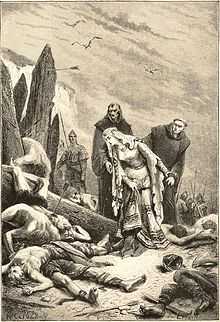Edith the Fair
| Edith the Fair | |
|---|---|
 Edith discovering the body of Harold Godwinson | |
| Born | c. 1025 |
| Died | c. 1086 |
| Religion | Chalcedonian Christianity |
| Spouse(s) | Harold Godwinson |
| Children |
Godwin Edmund Magnus Gunhild Gytha |
Edith Swannesha (Old English: Ealdgȳð Swann hnesce, "Edith [the] Gentle Swan"; c. 1025 – c. 1086), also known as Edith Swanneschals or Edith the Fair,[note 1] was the first wife or mistress of King Harold II of England.[1] She is also commonly known as Edith Swanneck (or Swan-Neck), but this comes from the folk etymology which made her in Old English as swann hnecca, "swan neck", which was actually most likely a corrupted form of swann hnesce, "Gentle Swan" .[2] She is sometimes confused with Ældgyth, daughter of Ealdorman Ælfgar of Mercia, and Harold's Queen consort.
Consort of King Harold
She may be identical with Eadgifu the Fair, who was one of the wealthiest magnates in England on the eve of the Norman Conquest. Their children included Gunhild, who became the mistress of Alan Rufus, and Gytha, who was taken by her grandmother to Denmark in 1068.[1] Gytha was addressed as "princess" and married the Grand Duke of Kiev, Vladimir Monomakh.[3]
Though King Harold II is said to have lawfully married Edith of Mercia, the widow of the Welsh ruler Gruffydd ap Llywelyn whom he had defeated in battle, that marriage in spring 1066 is seen by most modern scholars as one of political convenience.[4] Mercia and Wales were allied against England, and the marriage gave the English claim in two very troublesome regions, and also gave Harold Godwinesson a marriage deemed "legitimate" by the clergy, unlike his longtime common law marriage with Edith the Fair.
Edith the Fair was remembered in history and folklore chiefly because it was she who identified Harold's body after the Battle of Hastings.[5] The body was horribly mutilated after the battle by the Norman army of William the Conqueror, and, despite pleas by Harold's mother for William to surrender Harold's body for burial, the Norman army refused, even though Harold's mother offered Harold's weight in gold. It was then that Edith the Fair walked through the carnage of the battle so that she might identify Harold by markings on his chest known only to her. It was because of Edith the Fair's identification of Harold's body that Harold was given a Christian burial by the monks at Waltham Abbey.[6] This legend is recounted in the well-known poem by Heinrich Heine, "The Battlefield of Hastings" (1855), which features Edith the Fair (as Edith Swan-Neck) as the main character and claims that the 'marks known only to her' were love bites.
Historical fiction
The relationship between Harold Godwinson and Edith Swanneschals is the subject of several novels
- Helen Hollick - Harold the King
- G. A. Henty - Wulf the Saxon (1894)
- Julian Rathbone - The Last English King (1997)
- Edward Bulwer-Lytton- Harold, the Last of the Saxons (1848)
- G K Holloway - 1066: What Fates Impose (2013)
- Carol McGrath - The Handfasted Wife (2013)
Ealdgyth was portrayed by Janet Suzman in the two-part BBC TV play Conquest (1966), part of the series Theatre 625.
The German poet Heinrich Heine wrote Schlachtfeld bei Hastings (published 1851, in Romanzero).[7] In this poem, Edith and two monks (Asgod and Ailrik) search the battlefield for the body of King Harold.
Notes
- ↑ Her first name is also spelled Ealdgyth, Aldgyth, Edeva or Eddeva, and sometimes appears as Ēadgȳð and Ēadgifu. (Compare Godgifu which was modified to Godiva in Latin texts.)
Citations
- ↑ 1.0 1.1 Williams, Ann (2004). "Eadgifu [Eddeua] the Fair [the Rich] (fl. 1066), magnate". Oxford Dictionary of National Biography. Oxford University Press. doi:10.1093/ref:odnb/52349. Retrieved 19 March 2014. (subscription or UK public library membership required)
- ↑ Ardagh, Philip. Philip Ardagh's Book of Kings, Queens, Emperors and Rotten Wart-Nosed Commoners.
- ↑ Poole, Russell Gilbert (1998). Old English Wisdom Poetry. D.S.Brewer. p. 238. ISBN 978-0859915304.
- ↑ Jones, Kaye (2011). 1066: History in an Hour. p. 32.
- ↑ Jones, Kaye (2011). 1066: History in an Hour. p. 33.
- ↑ Mason, Emma (2004). The House of Godwine: The History of a Dynasty. p. 178.
- ↑ "Schlachtfeld bei Hastings". Projekt Gutenberg-DE. Retrieved 27 October 2014.
Sources
- A History of Britain: At the Edge of the World, 3500 BC - 1603 AD by Simon Schama, BBC/Miramax, 2000 ISBN 0-7868-6675-6
- The German Classics of the Nineteenth and Twentieth Centuries, Volume 06: Masterpieces of German Literature Translated into English in Twenty Volumes by Kuno Francke www
.gutenberg .org /etext /12473 - Great Tales from English History: The Truth About King Arthur, Lady Godiva, Richard the Lionheart, and More by Robert Lacey, 2004 ISBN 0-316-10910-X
- House of Godwine: The History of Dynasty by Emma Mason, 2004 ISBN 1-85285-389-1
- Ancestral Roots of Certain American Colonists Who Came to America Before 1700 by Frederick Lewis Weis, Lines: 176-2, 176A-4, 177-1
- 'Who Was Eddeva?' by J.R. Boyle, F.S.A.; Transactions of East Riding Antiquarian Society, Volume 4 (1896); pages 11-22
| Wikimedia Commons has media related to Edith the Fair. |